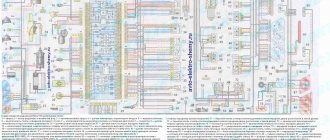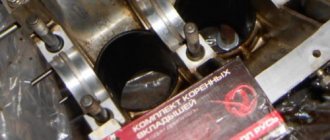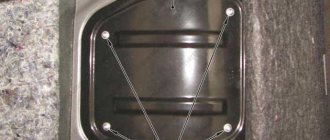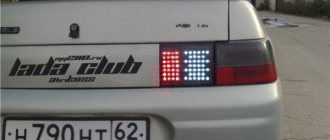VAZ-2108, or eight, is a Soviet and Russian car, produced from 1984 to 2004. The development history is noteworthy in that the work was carried out jointly with Porsche. Licenses were purchased for many components and assemblies from Western companies: Hardy Spicer - CV joints, Solex - carburetor, Lucas - front disc brakes and vacuum brake booster. The first VAZ model with front-wheel drive, unlike classic models, based on the VAZ-2101. The production of the car was launched with a “short” front wing, but this turned out to be impractical, since the plastic trim on the front end quickly “moved away” from the wings and became deformed from exposure to the sun. Next, a version with longer fenders and a hood was released, which eliminated the problem. Below are the wiring diagrams for the VAZ-2108. Electrical circuit diagrams will help you deal with any electrical problems in the VAZ-2108.
VAZ 2108 options
| Model | Option code | Location of controls | Execution | Engine | Injection system components and controller | Toxicity standards | Dashboard | Note |
| VAZ-2108 | 10 | left | “Norm” for the domestic market | 2108, 1.3 l, carburetor with contactless ignition system | — | R-83 | 2108 "low" | -> 01.00 |
| VAZ-21081 | 10 | left | "Standard" for the domestic market | 21081-10, 1.1 l, carburetor with contactless ignition system | — | R-83 | 2108 "low" | -> 05.97 |
| VAZ-21083 | 10 | left | “Norm” for the domestic market | 21083-50, 1.5 l, carburetor with contactless ignition system | — | R-83 | 2108 "low" | -> 09.00 |
| 10 | left | “Standard” for the domestic market “basic” | 21083-53, 1.5 l, carburetor with contactless ignition system | — | R-83 | 21083 "high" | 09.00-> | |
| 110 | left | “Norm” for the foreign market | 21083-50, 1.5 l, carburetor with contactless ignition system | — | R-83 | 2108 "low" | -> 09.00 | |
| 110 | left | “Standard” for the foreign market basic | 21083-53, 1.5 l, carburetor with contactless ignition system | — | R-83 | 21083 "high" | 09.00-> | |
| 143 | left | "Norm" for the Gulf countries | 21083-43, 1.5 l, carburetor with contactless ignition system | — | R-83 | 2108 "low" | ->09.00 with speed indicator | |
| VAZ-21083-01 | 10 | left | "Standard" for the domestic market | 21083-50, 1.5 l, carburetor with contactless ignition system | — | R-83 | 2108 "low" | -> 09.00 |
| 10 | left | “Norm” for the domestic market “basic” | 21083-53, 1.5 l, carburetor with contactless ignition system | — | R-83 | 21083 "high" | 09.00-> | |
| 110 | left | "Standard" for the foreign market | 21083-50, 1.5 l, carburetor with contactless ignition system | — | R-83 | 2108 "low" | ->09.00 | |
| 110 | left | The “norm” for the foreign market is basic | 21083-53, 1.5 l, carburetor with contactless ignition system | — | R-83 | 21083 "high" | 09.00-> | |
| 143 | left | "Standard" for the Gulf countries | 21083-43, 1.5 l, carburetor with contactless ignition system | — | R-83 | 21083 "low" | ->09.00 with speed indicator | |
| VAZ-21083-02 | 10 | left | "Lux" for the domestic market (basic) | 21083-53, 1.5 l, carburetor with contactless ignition system | — | R-83 | 21083 "high" | 09.00->;with fog lights and headlight cleaning |
| VAZ-21083-03 | 10 | left | "Lux" for the domestic market | 21083-50, 1.5 l, carburetor with contactless ignition system | — | R-83 | 21083 "high" | -> 09.00; with fog lights and headlight cleaning |
| VAZ-21083-20 | 10 | left | "Standard" for the domestic market | 2111-87, 1.5 l, with distributed fuel injection | GM, 2111-1411020-22 | R-83 | 21083 "high" | -> 03.00 |
| 10 | left | “Standard” for the domestic market (basic) | 2111-88, 1.5 l, with distributed fuel injection | Rus+B, 2111-1411020-70, 2111-1411020-71 | R-83 | 21083 "high" | 09.00->;with immobilizer | |
| VAZ-21083-21 | 10 | left | “Norm” for the domestic market (basic) | 2111-86, 1.5 l, with distributed fuel injection | Rus+B, 2111-1411020-60, 2111-1411020-61 | Euro 2 | 21083 "high" | ->03.00; with neutralizer and immobilizer |
| VAZ-21083-22 | 110 | left | for the foreign market | 2111-83, 1.5 l, with distributed fuel injection | GM, 2111-1411020-22 | Euro 2 | 2108 "low" | ->03.00; with neutralizer and immobilizer |
| 10 | left | Domestic Luxury (Basic) | 2111-86, 1.5 l, with distributed fuel injection | Rus+B, 2111-1411020-60, 2111-1411020-61 | Euro 2 | 21083 "high" | 09.00->;with neutralizer, immobilizer, fog lights and headlight cleaning | |
| VAZ-21083-23 | 10 | left | for the domestic market | 2111-82, 1.5 l, with distributed fuel injection | GM, 2111-1411020-22 | Euro 2 | 21083 "high" | ->03.00; with neutralizer and immobilizer |
| VAZ-21083-24 | 10 | left | for the domestic market | 2111-89, 1.5 l, with distributed fuel injection | Rus+B, 2111-1411020, 2111-1411020-70, 2111-1411020-71 | R-83 | 21083 "high" | with immobilizer |
| 20 | left | for the domestic market | 2111-86, 1.5 l, with distributed fuel injection | Rus+B, 2111-1411020-40 | Euro 2 | 21083 "high" | with neutralizer and immobilizer | |
| 21 | left | for domestic market | 2111-86, 1.5 l, with distributed fuel injection | Rus+B, 2111-1411020-60 2111-1411020-61 | Euro 2 | 21083 "high" | with neutralizer and immobilizer | |
| 110 | left | for the foreign market | 2111-86, 1.5 l, with distributed fuel injection | Rus+B, 2111-1411020-40 | Euro 2 | 21083 "high" | with neutralizer and immobilizer | |
| 130 | left | for the foreign market | 2111-74, 1.5 l, with distributed fuel injection | Rus+B, 2111-1411020-50 | Euro-3 | 21083 "high" | with neutralizer, immobilizer, rough road sensor and phase sensor | |
| 131 | left | for the foreign market | 2111-86, 1.5 l, with distributed fuel injection | Rus+B, 2111-1411020-40 | Euro 2 | 21083 "high" | with neutralizer, immobilizer and rear seat head restraints | |
| 138 | left | for Sweden | 2111-86, 1.5 l, with distributed fuel injection | Rus+B, 2111-1411020-40 | Euro 2 | 21083 "high" | with neutralizer, immobilizer and headlight cleaning | |
| 139 | left | for Scandinavian countries | 2111-74, 1.5 l, with distributed fuel injection | Rus+B, 2111-1411020-50 | Euro-3 | 21083 "high" | with neutralizer, immobilizer, rough road sensor and phase sensor, and headlight cleaning | |
| 143 | left | for Gulf countries | 2111-86, 1.5 l, with distributed fuel injection | Rus+B, 2111-1411020-40 | Euro 2 | 21083 "high" | with neutralizer, immobilizer, overspeed alarm | |
| 176 | left | for Israel | 2111-86, 1.5 l, with distributed fuel injection | Rus+B, 2111-1411020-40 | Euro 2 | 21083 "high" | with neutralizer, immobilizer, and tinted windows | |
| VAZ-21086 | 610 | right | Norm for the foreign market | 2108, 1.3 l, carburetor with contactless ignition system | — | R-83 | 21086 "low" | ->01.99 speedometer with combined MPH scale - km/h |
| VAZ-21087 | 610 | right | Standard for the foreign market | 21081-10, 1.1 l, carburetor with contactless ignition system | — | R-83 | 21086 "low" | ->01.99 speedometer with combined MPH scale - km/h |
| VAZ-21088 | 610 | right | Norm for the foreign market | 21083-50, 1.5 l, carburetor with contactless ignition system | — | R-83 | 21086 "low" | ->01.99 speedometer with combined MPH scale - km/h |
| VAZ-21088-01 | 610 | right | Standard for the foreign market | 21083-50, 1.5 l, carburetor with contactless ignition system | — | R-83 | 21086 "low" | ->01.99 speedometer with combined MPH scale - km/h |
| VAZ-21088-22 | 610 | right | for the foreign market | 2111-83, 1.5 l, with distributed fuel injection | GM, 2111-1411020-21 | Euro 2 | 21086 "low" | ->01.99 with neutralizer, immobilizer, speedometer with combined MPH scale - km/h |
A little history
The following basic systems are known that ensure the ignition of gasoline vapors in the internal combustion engine of a car:
- contact;
- contactless;
- microprocessor ignition system (MPI).
- Contact. Historically, this was the first attempt, it was quite successful and worked for many years. The diagram of such a system is shown below. The principle of operation of the device is simple - opening the contacts of the breaker breaks the primary circuit, which is why high voltage is induced in the secondary winding of the bobbin, which is directed by the distributor to one of the spark plugs. It was a simple, proven product, of course with its shortcomings, which were eliminated as technology and elemental base developed.
- Contactless. The operating principle is basically the same as the previous one, but the product is more reliable. In it, the contact mechanical breaker is replaced by electronic devices - a switch and a sensor. The diagram of such a product is shown in the figure.
- A microprocessor system that does not contain mechanical components and is built entirely on electronic components. The principle of operation also remains unchanged, the functional diagram of such a device is shown in the figure.
VAZ 2108 carburetor diagram
Front half of the diagram
| Position number on the diagram | Explanation of position |
| 1 | headlight |
| 2 | headlight wiper motor*; |
| 3 | engine compartment light switch |
| 4 | signaling |
| 5 | engine blower fan motor |
| 6 | fan motor connection sensor; |
| 7 | generator |
| 8 | electromagnetic throttle for connecting headlight washers |
| 9 | electromagnetic throttle for rear window washer connection* |
| 10 | solenoid valve for windshield washer connection |
| 11 | spark plugs |
| 12 | ignition distributor sensor |
| 13 | ignition salenoid VAZ 2108 |
| 14 | rear traffic light switch |
| 15 | TOZ indicator device |
| 16 | starter VAZ 2108 |
| 17 | battery |
| 18 | brake fluid level sensor |
| 19 | switch VAZ 2108 |
| 20 | TDC sensor 1st cylinder |
| 21 | diagnostic terminal block |
| 22 | ECU for carburetor electromagnetic throttle; |
| 23 | starter switch relay |
| 24 | carburetor limit switch |
| 25 | carburetor electromagnetic plunger |
| 26 | oil pressure control sensor; |
| 27 | windshield washer motor |
| 28 | electric heater fan motor |
| 29 | additional resistance of the electric motor of the interior heater |
| 30 | heater fan switch |
| 31 | electric windshield wiper motor |
| 32 | cigarette lighter |
| 33 | heater lever light bulb |
| 34 | portable light bulb socket |
* Installed on parts of manufactured cars.
Rear half of the diagram
| Position number on the diagram | Explanation of position |
| 35 | engine compartment lighting |
| 36 | glove box light bulb |
| 37 | fuse block VAZ 2108 |
| 38 | instrument lighting switch |
| 39 | handbrake control switch |
| 40 | brake light switch |
| 41 | steering column switch |
| 42 | size switch |
| 43 | hazard switch |
| 44 | rear fog light switch |
| 45 | fog light line fuse |
| 46 | rear window heating switch |
| 47 | side turn signals; |
| 48 | lamp |
| 49 | connector for connecting to an individual light fixture; |
| 50 | light button on the door pillars |
| 51 | ignition switch |
| 52 | ignition lock |
| 53 | dashboard |
| 54 | carburetor choke control switch |
| 55 | rear lights |
| 56 | meter for level indicator and fuel remaining; |
| 57 | rear window defroster |
| 58 | electric rear window wiper motor |
| 59 | room lighting fixtures |
| A | the order of conditional numbering of the terminals in the ignition switch block |
| IN | numbering order of the terminals in the windshield wiper electric motor block |
* Mounted on some passenger cars.
One-piece scheme
Healthy ! VAZ 2109 diagram.
How to check the ignition coil of a VAZ
If the ignition coil is faulty, the engine will not start. A characteristic sign of a faulty coil is its increased temperature when the ignition is turned off. This is easy to determine by touch.
Signs of a faulty ignition module may include the following:
- hesitant engine starting or failure to start;
- failures during sudden changes in speed;
- high fuel consumption;
- two cylinders do not work, the engine is feverish;
- lack of dynamics;
- a sharp drop in power;
- drop in power and thrust after warming up.
These symptoms may not only be caused by the ignition module. To determine the malfunction, it is enough to spend a few minutes diagnosing spark plugs, high-voltage wires and caps. This will eliminate the remaining elements of the ignition system and make sure that it is the ignition module that is faulty.
Checking the ignition coil is performed in one of 2 ways. The simplest one is to remove the central wire from the breaker-distributor, bring it to the motor housing and turn it with the starter, and a running spark should appear. After this, we check the energy supply to a separate spark plug, for which we unscrew the working spark plug, bring its contact to ground and attempt to start the engine. In this case, the spark should come from the wire to ground. If it is absent, the reason will be a malfunction of a system element such as the ignition coil.
To check the module in the second way, we only need a multimeter, then follow the step-by-step instructions:
- We check the power supply and the presence of pulses supplied from the ECU. We check the power between the central terminal (15) of the wire block connected to the module and the engine ground. When the ignition is on, the voltage should not be less than 12 V. Otherwise, either the battery is dead or the ECU does not work.
- We check the pulses from the ECU on the wiring block. We install one tester probe on connector 15, the second on the far right, then on the far left. The assistant cranks the engine with the starter, and at this time we record short-term voltage surges with a tester. If there are no impulses from the ECU, it is he who is to blame.
- We check the resistance on the secondary windings of the coils. We put the tester in resistance measurement mode and measure it at the high-voltage terminals of the module cover. Between pins 1 and 4 and pins 2-3, the resistance should be 5.4 kOhm. Otherwise, the module must be replaced.
- We check the resistance of the primary windings between contacts 15 and the rightmost, then the leftmost terminals. Nominal - 0.5 Ohm. Deviation is not allowed.
- Check the module for a short circuit. In ohmmeter mode, install one multimeter probe on the central terminal, the second on the metal body. There shouldn't be any resistance. If the device detects at least some resistance (other than unity or infinity), the module must be replaced.
Generator circuits
This section presents a diagram of a VAZ 2108 generator of two types. One of them is a 2108 carburetor generator circuit designed for the model 37-3701 generator mounted on carburetor engines. Another connection diagram for the VAZ 2108 generator is intended for the generator model 5102.3771, installed on cars with a VAZ-2111-80 injection engine.
Electrical circuit of generator 37.3701 carburetor engine
| Position number on the diagram | Explanation of position |
| 1 | generator VAZ 2108 model 37.3701 |
| 2 | negative valve |
| 3 | additional diode |
| 4 | positive valve |
| 5 | low battery warning light |
| 6 | dashboard |
| 7 | voltmeter |
| 8 | fuse block |
| 9 | additional resistors 100 Ohm, 2W |
| 10 | ignition switch |
| 11 | ignition switch |
| 12 | source of electricity |
| 13 | capacitor |
| 14 | rotor winding |
| 15 | voltage regulator |
The generator model 37.3701 is mounted on VAZ 2108 cars with carburetor engines.
Generator circuit 5102.3771 injection engine
| Position number on the diagram | Explanation of position |
| 1 | source of electricity |
| 2 | generator VAZ 2108 model 5102.3771 |
| 3 | Relay and fuse box |
| 4 | low battery warning light located on the instrument panel |
| 5 | ignition switch |
On a car with an injection engine mod. VAZ-2111-80 was standardly equipped with generator 5102.3771 (Russia), but generator 94.3701 can be installed instead.
The voltage to excite the generator when the ignition is connected is supplied to the “D+” contact of the regulator (the “D+” terminal of the generator) through control 4 located on the dashboard. When the ignition is connected, the light should glow, and after starting the engine, it should go out if the generator is working. A bright glow of the light bulb or its burning at full intensity indicates a malfunction of the generator.
Electrical circuit for testing a generator on a bench
Electrical circuit for checking a generator with an oscilloscope
Prevention measures
What preventive measures will help maintain the health of electrical wiring:
- All problems that arise in the operation of electrical devices must be resolved as quickly as possible. If there are a lot of them, normal operation of the car will be impossible.
- When installing new devices, the wiring should be laid where there are no rubbing parts and mechanisms, this will preserve its integrity . In addition, when laying, keep in mind that all wires must be reliably insulated.
- The use of homemade fuses in the mounting block is not permitted. If the fuse element has blown, then homemade devices (coins or jumper wires) can be installed only to get to the nearest store. Using such fuses can cause short circuits and even fire, so be careful.
- Periodically diagnose the performance of the generator, in particular, we are talking about its belt. It is necessary to ensure that the strap is always properly tensioned, since insufficient or excessive tension will also affect the operation of the electrical system.
- Twice a year, charge the battery, check the presence of electrolyte in the banks, and visually inspect the case for damage or cracks. Damage and cracks in the structure will lead to leakage of electrolyte, which, in turn, will cause the device to discharge.
- Try not to use cheap Chinese devices and appliances, for example, cigarette lighter splitters. As you know, the cigarette lighter socket is designed for a certain power, and if you decide to connect several devices to it at the same time, the load on the socket will increase significantly.
Have you encountered problems with wiring in your car?
Survey
- Yes
- No
- I don’t know (I don’t repair my car)
Loading …
Electrical diagram for connecting the VAZ 2108 starter
| Position number on the VAZ diagram | Explanation of the position on the diagram |
| 1 | starter VAZ 2108 brand 2113-3708010-00 or 29.3708, 423.3708. |
| 2 | source of electricity |
| 3 | magneto |
| 4 | Relay and fuse box |
| 5 | ignition switch |
| P1 | pull-in coil of traction relay |
| P2 | holding winding of the traction relay for connecting the starter |
A starter of brand 2113-3708010-00 from the Pramo company, produced in Russia, was installed on the car, but starters of brand 29.3708, 423.3708 can be installed. All starters are a DC electric motor with mixed excitation and an electromagnetic two-winding traction relay.
The microprocessor ignition system is equipped with:
- one coil, which is common to the nodes;
- dual or individual voltage generation device.
Each option has distinctive features:
- the common coil is mounted in devices with microprocessor ignition equipped with a distributor;
- an individual type of coil is mounted on a spark plug, which eliminates the need to install high-voltage conductors;
- Dual-type coils are mounted in direct ignition units. So, a pair of coils are mounted on a 4-cylinder engine. One is installed on a pair of cylinders 1 and 4, and the second on 2 and 3. A high voltage current is generated in each device. A spark is formed simultaneously in two combustion chambers. In one, the prepared fuel mixture ignites, and in the other, the spark works in vain.
Ignition circuit 2108
Here is a diagram of the contactless ignition of the VAZ 2108. The 2108 ignition connection diagram includes the 2108 switch and its connection diagram, as well as other devices, a list of which is given in this section.
| Position number on the VAZ diagram | Explanation of the position on the diagram |
| 1 | contactless sensor |
| 2 | ignition distributor sensor VAZ 2108 brand 40.3706 or 40.3706-01, |
| 3 | spark plugs |
| 4 | switch |
| 5 | Ignition solenoid |
| 6 | Relay and fuse block |
| 7 | ignition switch |
| 8 | ignition switch |
Equipment for the contactless ignition system of the VAZ 2108 car:
- Ignition distributor sensor - 40.3706 or 40.3706-01;
- Switch - 3620.3734, or 76.3734, or RT1903, or PZE4022;
- Ignition coil - 3122.3705 with a closed magnetic circuit, dry or type 8352.12
- Spark plugs - A17DVR, or A17DVRM, or A17DVRM1, or FE65PR, or FE65CPR
Important ! You need to carry a Hall sensor and a switch in your car. The breakdown of these devices is quite large, and it is impossible to repair them or replace them with another one. If they break, the engine cannot be started, but changing them is easy. The same applies to the ignition coil, but it is more durable than the sensor and switch. If absolutely necessary, it can be replaced with a solenoid from another car.
Important ! Electronic ignition circuit for the injection engine of the VAZ-2111-80 model of the VAZ 2108 passenger car.
What elements does the diagram include?
The main components of the electrical circuit in the VAZ 2108:
- ignition system, including a lock, starter, spark plugs, distributor, as well as high-voltage wires transmitting current;
- sound signal unit;
- electric windows, if the car is equipped with them;
- heating system;
- heated rear window;
- lighting, including headlights, side lights, turn signals, brake lights, interior lights, as well as fog lights, if the car is equipped with them;
- a windshield and rear window washing system, including windshield wiper blades and an electric motor;
- cooling Fan;
- dashboard, where the speedometer, tachometer, fuel and engine temperature gauges, econometric gauge, as well as all indicators are located;
- steering column switches for controlling turn signals, washer systems, and high beams;
- battery;
- generator unit.
Full diagram of the G8 equipment
In general, the electrical circuit consists of many devices, and it doesn’t matter whether we are talking about an injector or a carburetor, whether the car is equipped with a high tidy or a low panel.
The main components of any electrical system, without which engine operation is impossible, are the following:
- Dashboard. If it fails, operation of the vehicle will be impossible. Even if the car starts, the driver will not be able to know how fast it is moving, what the engine temperature is, or how much fuel is left in the tank.
- An ignition system that combines several components that we have already talked about.
- The battery, thanks to which the power unit is started, also allows electrical appliances and equipment to operate when the engine is turned off.
- The generator unit is one of the main ones, since it is it that supplies power to all electrical equipment when the motor is functioning. When the car is running, the generator also powers the battery, allowing it to replenish the energy it expended to start the engine.
- Mounting block with fuses located in the engine compartment, under the windshield opposite the driver's seat.
1. Generator device connection diagram
2. Contactless ignition system
Wiring diagram for windshield wiper and washer
| Position number on the VAZ diagram | Explanation of the position on the diagram |
| 1 | motor with gearbox for windshield wipers |
| 2 | thermobimetallic fuse |
| 3 | electric motor for washer pump VAZ 2108 brand 33.5205 |
| 4 | electromagnetic throttle for windshield washer |
| 5 | relay and fuse block |
| 6 | ignition lock |
| 7 | ignition switch |
| 8 | switch for windshield wipers and washer |
| K3 | windshield wiper switch |
| A | sequence of conditional numbering of contacts in the wiper block |
| B | to terminal “30” of the generator |
| A | 2nd speed cleaner brush |
| b | 1st speed cleaner brush; |
| V | limit switch spring plate |
| g, d | limit switch contact posts |
| C1, C2 | noise suppression capacitors |
| L1, L2 | chokes |
Windshield wipers are available from domestic or Hungarian manufacturers. They are interchangeable in connection and mounting dimensions. The motors with gearboxes of these devices are also interchangeable, although they have some differences in design.
Wiring - VAZ 2109: interior and engine compartment modifications
Perhaps, without exaggeration, we can say that the most popular AvtoVAZ model is the family of front-wheel drive cars. And many owners strive to change the VAZ 2109 on their own, introducing various improvements that affect the standard wiring.
But are they all justified? This will be discussed in this article.
Front-wheel drive VAZ 2109 is a leader in the number of successful tuning experiments
Today you can find several modifications of the car, in which the wiring diagram for the VAZ 2109 has significant differences.
In particular, the car is equipped with:
- Carburetor power unit;
- Injection power unit.
Generalized wiring diagram for a VAZ 2109 with a carburetor type
In addition to the desire to change or improve something, owners of early models of this car are faced with the need to replace the engine due to the exhaustion of its service life.
Wiring diagram for windshield wiper 2108 tailgate glass
| Position number on the VAZ diagram | Explanation of the position on the diagram |
| 1 | electric washer pump motor |
| 2 | electromagnetic throttle for connecting the rear window washer |
| 3 | Relay and fuse box |
| 4 | ignition switch |
| 5 | switch for windshield wipers and washer |
| 6 | rear window cleaner |
| A | to contact "30" magneto |
| B | plan for conditional numbering of contacts in the terminal block of the rear window wiper |
On some cars, tailgate glass cleaners may be installed along with electromagnetic washer chokes.
Low and high voltage wires:
High voltage wires:
1. High-voltage wires serve to transmit high-voltage current from the ignition coil itself and to each cylinder spark plug.
2. Cars of the Samara family are equipped with high-voltage wires with a distributed resistance of 2550±270 Ohm/m.
3. Under no circumstances try to start a car with a broken high-voltage voltage circuit, that is, to put it simply: The car’s engine does not need to be started with the high-voltage wires removed, as well as with the ignition distributor cap removed. Such actions can lead to failure of the ignition system elements, as well as breakdown of the insulation, so be careful.
4. It is also not recommended to handle or touch high voltage wires when the car engine is in working condition, because this can lead to electrical injury.
Note! When checking high-voltage wires for the presence of a spark, it is recommended to disconnect the wires with the engine turned off, and if the engine is started, the wires should be secured at a distance of 5-10 mm from the mass of the car, and these wires should not be in your hands, even in only if you hold them with a tool!
Low voltage wires:
1. Every person has encountered such wires in his life; they are most often of small thickness and have a very flexible shape, unlike high-voltage wires.
2. And most often, low-voltage wires have a combined color, that is, they come in both red and blue, and have many other colors.
3. A striking example of where the low voltage wires are connected is the same ignition coil, because if you look at it carefully, then on its side you can see two wires, one of which is “red” and the other “blue”. (see photo above)
Heater fan motor connection diagram
| Position number on the VAZ diagram | Explanation of the position on the diagram |
| 1 | Relay and fuse block for VAZ 2108 |
| 2 | ignition switch |
| 3 | additional resistor |
| 4 | electric heater fan motor VAZ 2108 brand 45.3730 |
| 5 | heater electric motor switch |
| A | to terminal "30" magneto |
Electrical diagram of the rear window heating system
| Position number on the VAZ diagram | Explanation of the position on the diagram |
| 1 | Relay and fuse box |
| 2 | rear window heating connector |
| 3 | ignition switch |
| 4 | rear window heating switch; |
| 5 | rear window heating connection control |
| 6 | rear window heater |
If the glass does not warm up when the heating is connected, you need to check fuse F4, the wires and their connections, as well as the switch and relay 2.
If the rear window heater breaks down, the manufacturer recommends replacing the entire glass, but now the retail chain has special kits for repairing broken heater threads, which consist of the necessary components, tools and instructions for use.
What can be changed in the electrical circuit
Let's figure out what exactly car owners undergo alterations.
Moreover, we will indicate only those alterations that are not prohibited by the manufacturer and current regulations:
- Installation of a new instrument panel;
- Alteration of internal (interior) lighting;
- Installation of additional turn signal indicators in the rear view mirrors;
- Installation of additional headlights (fog lights);
- Installation of an acoustic and multimedia system;
- Immobilizer installation.
Wiring diagram for VAZ 2109i with a high panel
For reference: the visual differences between the standard panel and the “high” one are that the radio compartment is moved to the level of the dashboard. Accordingly, the wiring on the VAZ 2109 under the instrument panel must be replaced.
Interior modifications
Many owners come to mind with the desire to improve the lighting in the car interior.
Let us remind you that inside a passenger vehicle there are several places equipped with lighting sources:
- The salon itself (interior lighting);
- Glovebox;
- Cigarette lighter;
- Instrument panel (instrument cluster lamp and symbol lamp)
Layout of incandescent lamps for a VAZ 2109 car
If you, as the owner, like a high panel in the cabin, then you cannot do without replacing the standard wiring. Because the:
- Control devices have a different location on the panel;
- The standard length of wires is not enough;
- Terminal blocks may also differ.
Electrical wiring on a VAZ 2109 in the process of connecting to devices
. Accordingly, without replacing the electrical wires it will not be possible to use:
- instrumentation;
- on/off buttons for various devices.
Differences in the terminal blocks of the “low” and “high” instrument panel
As for making changes to the instrument panel lighting, today there are sets of special lamps on sale along with the wiring with which they are connected to the car’s electrical network.
Why do you think the owner needs a GAZelle wiring diagram?
Tuned instrument panel lighting for VAZ 2109
You can install such kits yourself; it is only important to adhere to accuracy and safety rules.
Advice: carry out all electrical wiring replacements and connecting instrumentation only with the battery disconnected.
Connection diagram for the VAZ 2108 instrument cluster with a “low” panel (rear view)
| Position number on the VAZ diagram | Explanation of the position on the diagram |
| A | plan for conditional numbering of terminals in the instrument cluster blocks |
| A | PCB joints for instrument cluster without socket 17 |
| 1 | voltmeter |
| 2 | instrument lighting bulbs |
| 3 | antifreeze heat indicator |
| 4 | rear window heating control |
| 5 | high beam headlight control |
| 6 | backup control |
| 7 | rear fog light indicator light |
| 8 | size control |
| 9 | direction indicator control |
| 10 | "STOP" indicator light |
| 11 | oil pressure check |
| 12 | handbrake indicator light |
| 13 | emergency signal control |
| 14 | checking the brake fluid level; |
| 15 | carburetor throttle warning light |
| 16 | battery discharge control |
| 17 | socket for the relay-interrupter of the handbrake indicator light |
| 18 | gasoline level indicator |
| 19 | fuel reserve control |
The connections of the instrument cluster are made by printed wiring on a foil getinax plate. The plate is attached to the back of the case.
Table 9-4. Purpose of plugs in the MC 2713-02 controller connector
| Plug no. | Plug purpose |
| 1 | EPHH valve control signal output |
| 2 | Supply voltage supply, +12 V |
| 3 | Output to the SZ signal switch |
| 4 | Output to VK signal switch |
| 5 | NO output for diagnostics |
| 6 | Input from carburetor limit switch |
| 7 | UI output for diagnostics |
| 8 | Input H01 for signal from NO sensor |
| 9 | UI input 1 for signal from the UI sensor |
| 10 | Total (weight) |
| 13 | Diagnostic output |
| 15 | Input for signal from temperature sensor (common) |
| 16 | Input for signal from temperature sensor |
| 18 | UI2 input for signal from the UI sensor |
| 19 | Input H02 for signal from NO sensor |
The “Channel Select” signal, or VC (II, in Fig. 9-16, a), has an angular pulse duration of 180° along the crankshaft. The moment of sparking corresponds in cylinders I and IV to the transition from a low signal level to a high one, and in cylinders II and III - from a high level to a low one.
The “Start of reference” signal, or BUT (III, in Fig. 9-16, a), is generated once per revolution of the crankshaft. The transition from low to high level corresponds to the position of the pistons of cylinders I and IV at TDC.
The “Angular impulse” signal, or UI (IV, in Fig. 9-16, a), is generated 128 times (according to the number of teeth on the flywheel rim) per revolution of the crankshaft. Therefore, the period of the UI signal is 2.8° along the crankshaft.
All controller outputs are designed as an “open collector” transistor of an npn structure with a load capacity of no more than 10 mA.
The purpose of the plugs in the controller connector is given in table. 9-4.
The switch is two-channel, type 42. 3734. Based on the control pulses (SZ and VK) of the controller, it produces:
— alternate switching on of channels and, consequently, ignition coils;
— formation of current pulses during the time tн (Fig. 9-16, b) accumulation in the primary windings of the ignition coils;
— the amplitude of the current pulses I— (see oscillogram V in Fig. 9-16, b) is equal to 8-10 A, and the accumulation time to in the crankshaft speed range from 750 to 4500 min1 and with a supply voltage of 14 V should be 9 -4 ms. The amplitude of the voltage pulses U— (see oscillogram VII) on the output transistors of the switch at the moment of interruption of the primary current (I—) is 350-400 V.
The purpose of the output plugs in the switch connector is given in Table. 9-5.
Books and diagrams for repairing VAZ 2108
Here you can download the following books on the repair and operation of the VAZ 2108 passenger car and its modifications.
- Catalog of spare parts for VAZ-2108, VAZ-2109 cars and their modifications / 1992
- 160 pp.
- Size - 72.8 MB
- Format - pdf
- 1989
- 1996
Device and principle of operation
First, you need to determine: what type of power supply to the engine is currently subject to discussion. After all, the carburetor and the injector have completely different devices, and each of them has its own electrical circuit. You and I will talk about the type of power supply for the VAZ 2108 engine - a carburetor.
The wiring originates from the battery. Typically, a 12 volt (6 amp) battery is installed. On its way to various appliances, electricity passes through the fuse box. Further, it stabilizes its power using a number of devices: a switch, a voltmeter and an econometer.
After this, the electrical circuit is distributed directly to the main components of the VAZ 2108 devices. Let's start with the lighting devices. These include: headlights, low beam and high beam, engine compartment lighting, taillights, turn signals, interior lighting, and license plate lighting. Each of the above elements receives a different amount of energy. For example, for high beams, the current will be more powerful than for dimensions.
As for the operation of the VAZ 2108 engine, the following devices are required: a generator, control systems responsible for the carburetor, starter, ignition coil, distributor and spark plugs. The wiring diagram transfers electricity from the ignition coil to the spark plugs. In this case, while the engine is running, the generator is turned on. The distributor is responsible for distributing the spark between the combustion chambers of the cylinders. Each cylinder has its own stroke sequence, which is determined by the engine diagram.
The control systems responsible for the carburetor must open the valves in time, helping to form the correct combustible mixture in the float chamber. They also regulate the operation of the solenoid valve.
The carburetor has a simpler wiring diagram than the injector. This is because the injector circuitry involves electrically controlling the injection and mixture formation, while the carburetor does most of this work mechanically.
Further, the electrical voltage circuit in the VAZ 2108 car includes devices designed to improve driving safety and comfort. These include: air conditioning, heater, windshield and headlight washers, radio, and horn.
Also, the VAZ 2108 car has sensors that determine the temperature and level of fluids necessary for engine operation. Each of them is also powered by a battery. Sensor indicators are displayed on the instrument panel so that the driver can see them. The dashboard of the VAZ 2108 includes 16 indicator lights, a speedometer and a tachometer.











